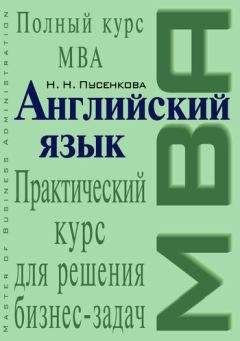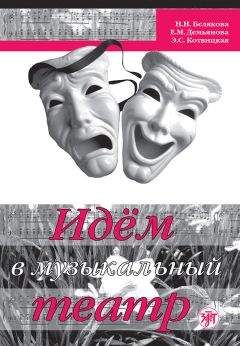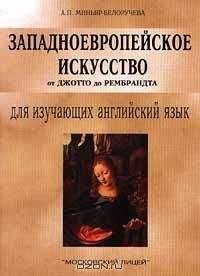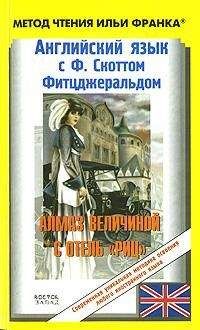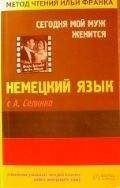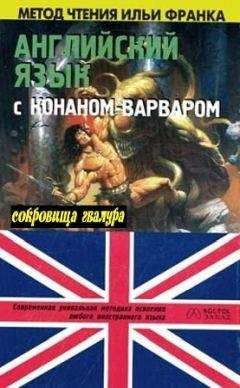Алла Миньяр-Белоручева - Западноевропейское искусство от Хогарта до Сальвадора Дали
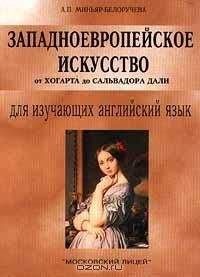
Скачивание начинается... Если скачивание не началось автоматически, пожалуйста нажмите на эту ссылку.
Жалоба
Напишите нам, и мы в срочном порядке примем меры.
Описание книги "Западноевропейское искусство от Хогарта до Сальвадора Дали"
Описание и краткое содержание "Западноевропейское искусство от Хогарта до Сальвадора Дали" читать бесплатно онлайн.
Тексты настоящего пособия охватывают почти три века истории западноевропейского искусства от Хогарта до Сальвадора Дали. Это позволяет обучаемым наряду с усвоением обширного лексического материала, приобрести культурологические знания, поскольку тексты содержат информацию о жизни и творчестве крупнейших западно-европейских художников XVIII – XX вв. Система упражнений направлена на усвоение лексического материала и развитие навыков устной речи.
Данная книга является второй частью цикла учебных пособий «Западноевропейское искусство (для изучающих английский язык)». В первую книгу вошли тексты, охватывающие пять веков западноевропейской живописи oт Джотто до Рембрандта. Данное пособие предназначено для студентов-искусствоведов, учащихся классических гимназий, лицеистов и всех изучающих английский язык и интересующихся западноевропейским искусством.
Execution of the Emperor Maximilian of Mexico – «Казнь императора Мексики Максимилиана»
Salon des Refuses – «Салон отверженных»
TasksI. Read the text. Make sure you understand it. Mark the following statements true or false.
1. Manet was the founder of Impressionism.
2. Manet admired Giotto, Ingres and Delacroix.
3. In the Luncheon on the Grass Manet was striving to produce three-dimensional forms on a flat surface.
4. Courbet liked the Luncheon on the Grass. 4. Manet never painted subjects from contemporary history. 6. A Bar at the Folie-Bergere is a brilliant restatement of Manet's earlier interest in the human figure.
II. How well have you read? Can you answer the following questions?
1. Where did Manet study painting?
2. What did Manet exhibit in 1863? How was this painting accepted by the public?
3. Why did the Luncheon on the Grass create an uproar? What had Manet wittily adapted in this picture? What did Manet point out by this painting? What did the erasure of form allow Manet to do? What enigma did Manet pose in this work of art?
4. What event does the Execution of the Emperor Maximilian of Mexico record? How did Manet treat the incident? How are the figures arranged?
5. What picture was painted two years before Manet's premature death? What is depicted in the background? What role does the mirror play in this picture? What does this mirror recall?
6. Why is A Bar at the Folie-Bergere considered to be the most complex image in the history of art? What makes this painting the most monumental accomplishment of the Impressionists?
III. i. Give Russian equivalents of the following phrases:
an insoluble enigma; the brilliant brushwork; immediate vision; illumination comes from the direction of the observer; a subject from contemporary history; the broken brushwork; to record an event; to make a close study of; to take a snapshot of the scene; a tragic subject; to give up the Hat style; to adopt the brilliant palette; an elaborately staged protest composition; the reflection in the mirror.
ii. Give English equivalents of the following phrases:
неразрешимая загадка; сосредоточиться на свете; великолепный мазок; отказаться от плоского стиля; запечатлеть событие; богатая цветовая гамма; разорванный мазок; подражать композиции и позам гравюр XVI в.; отражение в зеркале; свет исходит со стороны зрителя; тщательно изучить; трагическая тема.
iii. Make up questions of your own with the given phrases.
iv. Arrange the following in the pairs of synonyms:
a) brilliant; to eliminate; broken; tragic; subject; to give up;
b) disastrous; to refuse; theme; to exclude; split; dazzling.
IV. Here are descriptions of some of Manet's works of art. Match them up to the titles given below.
1. The picture consists of coloured uniforms, a briskly painted background, and puffs of smoke.
2. The grouping of a nude female figure and two fully clothed men in a public park created an uproar.
3. The entire background is constituted by the marble bar, laden with fruit, flowers and bottles of champagne and liqueurs.
a. A Bar at the Folie-Bergure
b. Execution of the Emperor Maximilian of Mexico
c. Luncheon on the Grass
V. Translate the text into English.
Формирование импрессионистов началось вокруг Эдуарда Мане, который получил образование в мастерской Кутюра, одного из столпов академического искусства. Однако подлинными учителями Мане явились Тициан, Веласкес, Гойя, Хале, Рубенс. Старые мастера, прежде всего, были для него предметом восхищения. Мане отличало от импрессионистов то, что он не отказался от широкого мазка, от обобщенной реалистической характеристики и сохранил синтетичность формы и цельность передаваемых характеров. Однако многое связывает Мане с импрессинизмом. Наиболее «импрессионистическое» произведение Мане – «Бар «Фоли-Бержер». В творчестве Эдуарда Мане, с одной стороны, нашли завершение классические реалистические традиции французского искусства XIX в., с другой – сделаны первые шаги в решении проблем, которые станут основными в развитии западноевропейского реализма XX в.
VI. Summarize the text.
VII. Topics for discussion.
1. Manet's early works of art.
2. Manet's Impressionist paintings.
3. Manet's artistic heritage.
Unit XI Monet (1840-1926)
The use of the name Impressionism to characterise the new style came from the first exhibition of members of the group at the recently vacated former studio of photographer Nadar in 1874, where they had often encountered the leaders of Parisian intellectual and cultural life. Claude Monet exhibited among others an extraordinary painting entitled Impression – Sunrise, Le Havre, painted two years earlier, described by Monet himself as «sun in the mist and few masts of boats sticking up in the foreground.» The title gave rise to the name applied to the entire movement. The exhibition was greeted with public derision, the like of which had never been experienced in Paris. Every tradition of European painting seemed to have been thrown aside. Not only form but substance itself has vanished. The picture was a mere collection of coloured streaks and blobs on a light blue ground. Today observers have no difficulty recognising a sailboat and a rowboat in the foreground, masts and equipment, haze, and smoke, all reflected in the rippled surface of the water. This revolutionary painting intended to correspond to the image the eye sees in an instantaneous glimpse of the port of Le Havre at sunrise, summed up the beliefs of the school. In retrospect, the name Impressionism seems one of the few appropriate names in the history of art.
*** *** ***
Monet was born in Paris, his father was a grocer, and the family soon moved to Le Havre on the coast of Normandy, where his father became a ship chandler, and the boy could constantly observe ships and the sea. This was very important for his later preoccupation with light, water, and human experience in relation to the unending stream of time. He started as a caricaturist. In 1858 he was introduced to landscape painting.
In 1867 Monet submitted to the Salon a revolutionary work. the huge Women in the Garden. The entire picture, more than eight feet high, was painted outdoors and required him to devise new methods in order to record the immediate impression of light on the dresses, the flowers, and the trees. The feeling of sunlight is warm and rich, but the colours are still local, though soft blue and lavender shadow does reflect into the faces of the women and their flowing dresses. The leaves are coloured in varying shades of green. In this and other pictures Monet established the new Impressionist subject – the moment of experience in light.
However successful from an artistic and historical point of view, the painting was a worldly failure. Manet made fun at it. But a few years later when he had come to understand Monet's style and adopted his brilliant colouring, Manet bought this picture for himself.
During the disorder of 1870-71 Monet fled, first to London, where he studied the art of Constable and Turner, then to Holland and Belgium, where he was interested chiefly in landscape. On his return to France Monet's style changed radically: he dissolved the object. In Impression – Sunrise, Le Havre, he demonstrated that colour belongs not to the object but to the moment of the visual experience. This was hard for his contemporaries to accept.
In 1873 Monet set up a floating studio in a boat on the Seine. The world passing before his eyes formed a continuous stream of experience, from which he singled out moments, recorded in series.
At the financially disastrous third Impressionist exhibition of 1877 Monet showed eight canvases devoted to the railway. In the Gare Saint – Lazare in Paris, of 1877, Monet depicted a locomotive drawing cars into a station. The iron-and-glass train shed offered to him a tissue of changing light and colour, dominated by blue and silver, but touched on the ground with tan, green, rose and gold. The Impressionists eliminated black from their palette and the shadows and the massive black locomotive were painted in blue. The people in Monet's picture are spots of blue; the puffs of steam are bubbles of blue and pearl. The locomotive's bumper is red, and this is the only bright colour in the picture. The fleeting effects that absorbed Monet's attention could not pause long enough for him to paint them. A picture like this was the product of several sessions.
By 1880 Monet's paintings were beginning to sell and he threw himself into the work with a passion as if nature were at once a friend and an enemy. He painted on a beach during a storm to ascertain the height and power of wind-driven waves, one of which swept him under (he was rescued by fishermen).
To achieve his effects Monet had to work systematically in series. By the 1890s, still faithful to Impressionist principles when others had long deserted them, Monet brought with him daily in a carriage, to the place chosen to paint, stacks of canvases on each of which he had begun the study of a certain light effect at a given moment of the day.
Monet painted series of cliffs, of haystacks, of poplars bordering a river, of the Thames in London, and the Grand Canal in Venice. But the most impressive was the series of views of Rouen Cathedral. This building an example of Flamboyant Gothic dematerialisation of stone appealed to him as an analogue of his own Impressionist insubstantiality. Systematically he studied the effects of light and colour on the lacy facade. In 1895 he exhibited eighteen views of the facade and two other views of the Cathedral. Monet's moments had, in the process of being painted, become the work of art.
The painting known as Rouen Cathedral in Full Sunlight represents the moment just about noon when the low winter sun is still striking the southern flanks of the masses masonry, and has not yet entered the west portals, illuminated by reflections from the square in front. Dazzling as the cathedral paintings are, Monet was discouraged by the impossibility of registering with his hand what he saw with his eyes.
In 1899 Monet began a series of water landscapes that occupied him till his death twenty seven-years later. These late pictures are the most magical of all. He won his battle with nature by annexing it. He constructed an environment that he could control absolutely, a water garden filled with water-loving trees and flowers, and crossed at one point by a Japanese footbridge. Here in the gigantic canvases he submerged himself in the world of changing colour, a poetic fabric in which visual and emotional experience merge. Abandoning the banks the aged artist gazed into the water, and these paintings show a surface in which the reflections of sky and trees blend between the floating water lilies. In Monet's last works the stream of experience has become timeless. Monet symbolically conquered time.
Make sure you know how to pronounce thefollowing words:
Claude Monet; Impressionist; photographer; retrospect; Normandy; Japanese; Flamboyant; Gothic; Cathedral; Le Havre; Rouen; Seine; Thames; caricaturist; locomotive; instantaneous
NotesImpression – Sunrise, Le Havre – «Впечатление Восходящее солнце»
Women in the Garden – «Женщины в саду»
Gare Saint-Lazare in Paris – «Вокзал Сен-Лазер в Париже»
Rouen Cathedral in Full Sunlight – «Руанский собор в полдень»
TasksI. Read the text. Make sure you understand it. Mark the following statements true or false.
1. The first exhibition of the Impressionists was held in 1872.
2. In Impression – Sunrise, Le Havre, Monet demonstrated that colour belongs not to the object but to the moment of the visual experience.
3. At the third Impressionist exhibition in 1879 Monet showed ten canvases devoted to the railway.
4. By the 1890s Monet had long deserted the Impressionist principles.
5. In 1899 Monet began a series of seascapes that occupied him ten years.
6. The fleeting effects that absorbed Monet's attention could not pause long enough for him to paint them.
II. How well have you read? Can you answer the following questions?
1. Where was the first exhibition of the Impressionists held? Why was this exhibition greeted with public derision? What picture gave name to the whole movement? What does it represent? What did this revolutionary painting intend to correspond? What did this revolutionary painting intend to correspond?
2. What did Monet constantly observe in Le Havre when he was a boy?
3. What did Monet submit to the Salon in 1867? What is depicted in this painting? What did Monet establish in this painting? What was hard for Monet's contemporaries to accept? What was Manet's attitude to this painting?
4. Where was Monet during the disorder of 1870-1871? What did he study there?
5. What did Monet set up in 1873? What did Monet depict in the Gare Saint-Lazare in Paris? What offered to Monet a tissue of changing light and colour? What colour did the Impressionists eliminate from their palette? Why was the Gare Saint-Lazare in Paris the product of several sessions?
6. Why did Monet have to work in series? What series did Monet paint? What appealed to Monet? What did Monet exhibit in 1895? What does the painting known as Rouen Cathedral in Full Sunlight represent?
7. What are Monet's most magical pictures? What do they show? What battle did Monet win? What environment did Monet construct? What did Monet symbolically do?
III. i. Give Russian equivalents of the following phrases:
Подписывайтесь на наши страницы в социальных сетях.
Будьте в курсе последних книжных новинок, комментируйте, обсуждайте. Мы ждём Вас!
Похожие книги на "Западноевропейское искусство от Хогарта до Сальвадора Дали"
Книги похожие на "Западноевропейское искусство от Хогарта до Сальвадора Дали" читать онлайн или скачать бесплатно полные версии.
Мы рекомендуем Вам зарегистрироваться либо войти на сайт под своим именем.
Отзывы о "Алла Миньяр-Белоручева - Западноевропейское искусство от Хогарта до Сальвадора Дали"
Отзывы читателей о книге "Западноевропейское искусство от Хогарта до Сальвадора Дали", комментарии и мнения людей о произведении.





